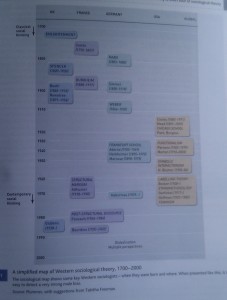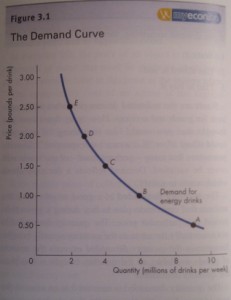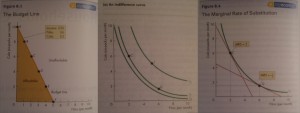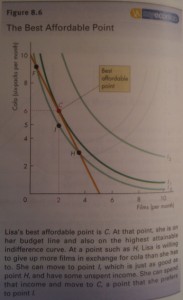Archive for the ‘Introduction’ tag
Basic concepts: Sociology no comments
Sociology is ‘the systematic, sceptical and critical study of the social. It studies the way people do things together.’ There are many different perspectives and it encompasses the widest global issues right down to the individual and their inner world.
Methodology
Although sociology is also a social science similar to my other subject choice of economics they work in different ways. Economics uses data to predict future spending etc, but sociologists are researchers and theorists. There is a degree of overlap, but the range of sociology is much wider and so sociology methods are more varied. Researchers find data, from experiments or data from everyday life (such as population statistics or Census data), and use is to draw conclusions about the world and society, Theorists go further and want to understand how this data fits into ‘the grand scheme of things’ and want deeper understanding of what is going on. Data alone cannot speak for itself and a wider understanding is necessary to gain real insight from the data. Theorists in sociology develop these wider ideas and help develop theoretical explanations for the data and how it fits in the world.
Although there can be some problems with the way sociology is studied. Firstly they are part of a changing world, one finding may be true one day, but not the next. Secondly, sociologists are part of society so it is difficult to remove oneself from what you are studying. Lastly, sociology knowledge becomes parts of society as it is known and therefore changes society. This cycle of knowledge has an impact of society itself.
Origins of Sociology
The Enlightenment caused a change in society. There was a move to rational thinking, empiricism and science and there was more focus on the individual.
Auguste Comte wanted to understand the ‘human drama’ of his time. He believed that if people had the knowledge of how society operates they would be able to build a better future. He divided his new discipline into two parts: how society is held together; and how society changes. From the Latin ‘to study society’ Comte descried his study as sociology.
Previous to Comte philosophers had been imagining the ideal society, not measuring and analysing society as it was. Comte wanted to develop a scientific approach to study society, thus he was proponent of Positism – to understand the world based on science.
Society is always changing and there have been many great leaps in society and how we look at it, for example during the Industrial revolutions. However, there is a more recent change that is of current interest to my research question: The Cyber Revolution. The Cyber Revolution is linked to the development of digital technology and the spread of information technologies that affect how we communicate and how it has become mainstream. The World Wide Web is a great example of this, launching recently in 1991 it is already embedded in all of our lives and is considered an international technology. This changes surrounding this digital age is a rapid change with large effects on society. The textbook tries to break down these changes:
The Digital Age: The shift of computerisation of life. The way there are computers is most everyday things.
The Cyborg Age: The way humans are becoming more adapted to using these technologies.
The Information Age: The rapid growth of production and availability of information and data.
The Network Society: The change in the way we are networked together through mobile phone and the internet.
The Virtual Age: The mediated nature of reality. We live in a world that is increasingly less direct and instead of face-to-face we communicate through computers and phones.
Another large aspect of sociology is that there are different theoretical perspectives of looking at things which guides thinking and research. Below is a simplified map of Western sociological theory, 1700-2000.
Classical/Traditional Perspectives of Sociology
Functionalism
‘Functionalism is a framework for building theory that sees society as a complex system those parts work together and interconnect.’ This perspective looks as social structure (finding stable patterns of human behaviour) and social function (all social structures have a function in society, either it be a handshake of family life). Merton also speaks of social dysfunctions, which cover any social patterns that have undesirable consequences for the operation of society. The critique for this perspective is that although this perspective was dominant until recently it presumes that society is stable and orderly. It also does not take into consideration inequality, such as class/gender/ethnicity issues.
Conflict perspective
‘The conflict perspective is a framework for building theory that sees society as an arena of differences and inequalities that generate conflict and change.’ This perspective complements Functionalism as it focuses on division and inequality. The critique of this perspective is basically the opposite of the Functionalism critique. The Conflict perspective glosses over the shared values and interdependence in society and focuses on the conflict and inequality. Both the Conflict and the Functionalist perspectives could also be criticised for being too broad and glossing over the smaller factors that make differences in society such as family and class.
Social action perspective
Contrary to the broad views of society seen in both Functionalist and Conflict perspective, the Social action perspective focuses on the smaller factors. One founder of social action theory is Max Weber who emphasised looking at a setting from the point of view of the people in it. His approach emphasised how human meaning and action shape society. A critique for this perspective is that this perspective helps us understand how people experience society and how they do things together. But by focusing on these smaller details broader social structures may be missed.
There are also contemporary perspectives such as feminism (looking as gender difference), Anti-racism (looking at race differences), postmodernism (looking at differences and complexities) and globalisation (looking at the larger world and how societies fit in it). The next post will further explore globalisation because I believe it is an important in relation to my research question. The globalisation of industry and society may lend some answers to why independent music can survive if the music industry has been made global.
Information and graphs summarised from:
Macionis, J.J. & Plummer, K. (2008). Sociology. A global introduction. Essex, England: Pearson Education Limited.
Basic concepts: Economics no comments
“A social science what studies the choices individuals, businesses, governments and entire societies make as they cope with scarcity and the incentives that influence.” Scarcity refers to not having enough money for food, or the inability to do something that you want to do because you have to work. We all face scarcity, but we need to make choices to cope with it, for example, choosing to work over choosing a fun activity because you need the money from working to pay bills. The choices we make are influenced by incentives. It can take the form of a reward or a penalty. If skipping work has a good opportunity of getting a much better job we may be more likely to choose to skip work. This is a just a very simple example, but it also works on a larger scale. If the price of computers drops we may as a society decide to buy more and furnish all schools with good computers.
Economics is a large area is we take into consideration individuals, businesses and entire societies; therefore it is broken up into Microeconomics (individuals and business choices) and Macroeconomics (national and global economy).
One of the most common economic phrases is “supply and demand”. Demand refers to the relationship between how many people want a product and how much it costs. Supply refers to the relationship between the quantity of the product created and its price. An increase in demand would mean an increase in price and quantity supplied. An increase in supply would mean a decrease in price and increase in quantity required.
Household consumption choices are limited by income. The budget line is a way of seeing income that can be spent and how it can be spent. If prices of items you buy drop or income increases the Budget Line will change.
Indifference curves are used to show within what combinations of goods the consumer is indifferent to having. For example someone may not mind swapping a packet of cigarettes for an extra drink at the bar or even extra chocolate during the week at work.
Marginal Rate of Substitution is the rate someone will give up n of x to get n of y. If the rate is high an individual will give up a large quantity of x for a small quantity of y. This works the other way round if the rate is low, they will only give up a small quantity of x for a large quantity of y. However, we must be aware that the substitution must compliment or be a fair substitute for the item. If you are very thirsty and are offered a truck load of peanuts for one can of drink you may still decide to keep the drink!
By using these three ideas we can develop a model to predict consumer behaviour. We assume someone will pick the point that benefits them the most, so if it fits inside the budget line (indicating it is affordable) and it lies on the indifference curve (indicating it is a option someone would be happy with) and has a marginal rate of substitution that is equal to the relative price of the items desired, this gives the most affordable point and hopefully that is what someone would choose.
Elasticity is the measurement of how variables can affect each other. An example would be lowering prices to sell more.
Market power refers to the ability to influence the market. A monopoly is when a company has goods or services with no close substitute and has a barrier stopping other companies selling similar products or services. An example would be energy suppliers or the Post Office. Barriers stopping other companies could be a government contract or patent or copyright issues.
Advertising increases total cost of a product, but if the advertising increases sales the total cost of a product will fall.
Uncertainty and Risk
Uncertainty is linked to how certain you are of an event occurring. For example a farmer can never be certain crops planted will grow because they cannot be certain of the weather and other factors that could affect crop growth. Risk is a situation where more than one outcome may occur and the probability of those happening. Probability can be measured accurately or we may have to look at past experience and make a judgement called subjective probability. The cost of risk can be accessed from these probabilities. A person’s attitude towards risk can be assessed using their wealth and how much utility someone attaches to a given amount of wealth. The more wealth you have the higher the utility and the larger risks can be made.
Microeconomics
If the aim of a company is to maximise profit. They can be in any of the below modes of operation:
- Make an economic profit (average total cost is less than the price of each product)
- Make a normal profit (where economic profit is zero)
- If the price is between average total cost and average variable cost the company is loss-minimising. By continuing to produce it may still recover, if it stops it will lose money.
- If the price is below the average variable cost the company should go into shutdown. Losses are minimised by not producing more (wasting money of products that are selling at a loss).
Information and graphs summarised from:
Parkin, M., Powell, M., & Matthews, K. (2008). Economics. Essex, England: Pearson Education Limited.
.
From a Psychology background I can’t help but stick this in to reflect upon. In order to utilise economics you are assuming that the consumer or the company has the aim of maximising profits and that they will always make the best rational decision. However, luck and cognitive dissonance may be more of a factor than simply “working out the numbers”. Daniel Kahneman: How cognitive illusions blind us to reason.
Economics 101 no comments
In order to establish whether i can look at economics in sufficient detail to make it a worthwhile exercise (in relation to the question of reputation) i’ve been focusing on that for the last ten days. Things are a bit more promising i think; provided i concentrate on the social capital side of things i’m confident i can tie everything together coherently.
I’ve been making my way through Economics by Parkin, Powell and Matthews, which i’ve found very accessible and easy to read. The authors try to illustrate reasonably complex concepts (for me they are reasonably complex, anyway) with simple analogies, the majority of which for some reason seem to include David Beckham. Below are the key things i’ve got from the first part of the book.
What is Economics?
It is the social science that studies the choices that individuals, businesses, governments and entire societies make as they cope with scarcity and the incentives that influence and reconcile those choices.
Microeconomics & Macroeconomics
Microeconomics is the study of choices that individuals and businesses make, the way these choices interact in markets and the influence of governments. Macroeconomics studies the performance of the national and global economy.
Two Key Economic Questions
How do choices end up determining what, how and for whom goods and services get produced?
When do choices made in the pursuit of self-interest also promote the social interest?
Trade-Offs and Opportunity Cost
Trade-offs are a way of conceptualising the process of making a choice between alternatives. For example, when you choose to write your IDR blog rather than watchint the One Show you face a trade-off. By writing this blog i am (hopefully) becoming better educated and giving myself a better chance in doing well in this course, which may lead to a better career later down the line. But i am missing the One Show, so i am trading off current entertainment(?!) with my future ‘performance’. Linked to this is opportunity cost. If i want to go and see ‘Due Date’ this weekend, the cost of the ticket will preclude me from having a pub lunch on Sunday. Therefore, the opportunity cost of seeing Due Date is the pub lunch i won’t have; that is, the pub lunch is the highest valued alternative that i would have done if i did not go to the cinema.
Margins
If i study five nights a week instead of four, and my marks go from an average of 50 to 60, the marginal benefit of that extra night’s study is the difference between my old and new average – 10%. The marginal cost of getting that extra ten percent is the night i lose socialising. In order to evaluate the benefits, i would have to establish whether the extra marks outweigh the cost of socialising less.
Human Nature and Social Interest
There is an economic assumption that humans act in their self interest; that is, they make the choices that get hte most value for them based on their values. A question the book seems very keen on addressing is when self-interested acts are alos in the social interest.
How Economics is Studied
Economics is not an experimental science, ands as such has to be studied through other means. Given that you cannot really conduct bound economic experiments in the laboratory, the book details and describes methods used to study economics. These include Observation and Measurement, Model Building and Testing Models.
I’ve been necessarily brief; there really is a lot of material that i’ve tried to distill down to the core components. Thus far it’s a rewarding task, and i feel quite comfortable with all of the concepts above although i’m fairly sure i had at least an elementary understanding of most of them. I’m going to press on with this book for the next week or so, as it has only touched on social capital and i think this will be the area that i can most strongly link back to my topic area.



